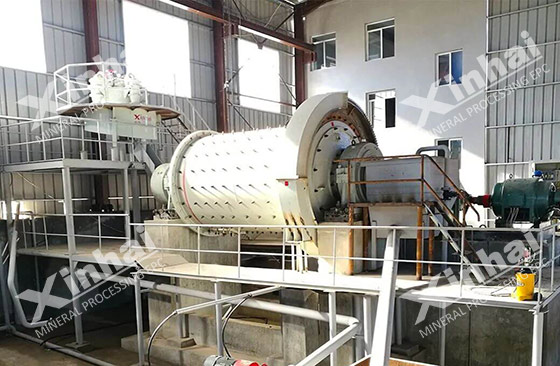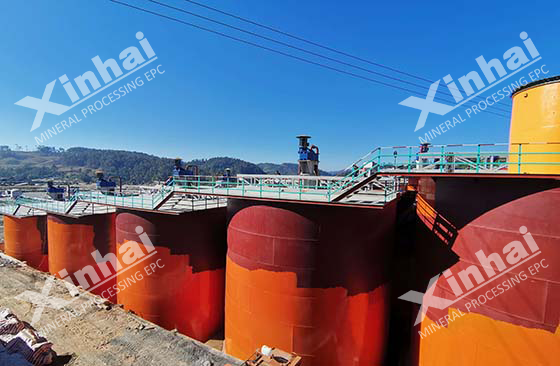
Tailings will be produced during the separation of metal ores, and there are useful minerals in the tailings that can be reused. In order to make full use of ore resources, it is crucial to adopt suitable comprehensive recovery technology for metal tailings. Since different ores have different components and properties, mineral processing tests are needed to determine the optional properties of the ores and improve the utilization efficiency of the tailings. The following will continue to introduce you to several comprehensive utilization technologies of ore tailings to help you better optimize the mineral processing process.

The gradual reduction of fluorite resources will restrict the development of fluorine chemicals. Recycling and utilizing associated fluorspar resources can alleviate the shortage of raw materials for fluorine chemicals. The grade of fluorspar in tailings is generally 17%-22%, which is the target mineral for separation and recovery. Non-target minerals are mainly quartz, feldspar and calcite. According to the particle size analysis of fluorite ore, flotation process can be used for recovery.
First, weak magnetic and strong magnetic separation are used to magnetically group the tailings. The grade of non-magnetic fluorspar is improved, the flotation feed of fluorspar ore is optimized, and the pressure of flotation is reduced. Fluorite concentrate is obtained after desilication after fluorite flotation.
Most non-ferrous metal mine tailings contain valuable elements such as iron and manganese. For a long time, mineral processing plants have only focused on the extraction of main elements and made less use of other useful elements in the tailings, resulting in low resource utilization. For complex polymetallic lead-zinc-manganese ores, in order to make full use of the manganese minerals and their weak magnetic properties, a strong magnetic separation process is used to recover manganese resources from the flotation tailings. In the separation process, a high-gradient strong magnetic separator is used to recover manganese carbonate, and weak magnetic separation is used to remove iron from the manganese coarse concentrate, so that higher-grade manganese concentrate can be obtained and the recovery rate is increased.

The process flow of recovering tungsten, molybdenum and bismuth from multi-metal tailings is as follows: the tailings raw materials are ground and classified through a closed-circuit grinding and classification circuit composed of a ball mill and a spiral classifier. The classifier overflows into the mixed flotation operation of bismuth and molybdenum. A rough selection, a selection and a sweep are performed to obtain the bismuth-molybdenum mixed concentrate. The scavenging tailings undergo shaking table gravity separation and magnetic separation to obtain tungsten concentrate and bismuth concentrate. Chute and shaker are used to discard some of the tailings. This process is a relatively common technology in mineral processing plants. It is simple to operate and widely used.
The key technologies of this process are mainly divided into three parts: (1) Pre-grading and dehydration: the generated tailings are naturally classified and dehydrated through hydraulic grouping boxes, and the tailings in the tailings pond are classified through a spiral classifier. (2) Grinding and flotation: Coarse-grained tailings are ground, and fine-grained tailings directly enter flotation. (3) Chemical system: Lime is used as a regulator, kerosene and black powder are used as collectors, No. 2 oil is used as a foaming agent, and flotation is carried out in a medium with a pH value of 10.

The gold grade of gold mine heap leaching tailings is low, and after years of heap leaching and disposal, the residual gold in the tailings is difficult to separate. The adoption of tailings slag crushing-grinding-all-mud cyanidation-carbon slurry gold extraction process can significantly reduce production investment costs and increase gold recovery rate. The specific process flow is: after the heap leaching tailings slag is crushed, screened, two-stage closed-circuit grinding and classification, and debris and impurities are removed, the slurry is concentrated and sent to the cyanidation system, and the gold-loaded carbon obtained is desorbed and electrolyzed. The electrolyzed gold mud can be smelted and cast into alloy gold after being washed with water and pickled.
The key to this technology is to add sodium cyanide before grinding, shortening the leaching time of the ore, saving leaching equipment, and reducing equipment costs and production costs. At the same time, this process uses energy-saving, efficient and advanced crushing equipment and grinding equipment to improve production efficiency while ensuring the stable operation of the production line.
The above is a brief introduction to the four ore tailings reprocessing technologies. According to the actual situation, the specific mineral processing process should be appropriately adjusted. Xinhai Mining recommends conducting mineral processing test analysis before customizing the process. The test results are an important data basis for process design and equipment selection. Reasonable tailings reprocessing processes and equipment can be obtained to improve ore resource utilization and concentrate recovery rates.
To find out more about our products and solutions, please fill out the form below and one of our experts will get back to you shortly.